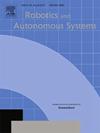基于vr的蛇形机器人运动控制的MPC算法研究
IF 4.3
2区 计算机科学
Q1 AUTOMATION & CONTROL SYSTEMS
引用次数: 0
摘要
蛇形机器人适用于复杂地形和有限空间的搜索、救援、探索和医疗程序。然而,这种欠驱动使得它们的控制和运动相当具有挑战性。目前的方法大多缺乏实时适应性、约束下的优化和有效的可视化工具。这项工作有助于通过使用模型预测控制和虚拟现实来填补欠驱动蛇形机器人的控制和运动方面的一些空白。以三自由度蛇形机器人模型为例,采用MATLAB和Unity仿真软件对五种控制策略进行了实现和验证。模拟包括“幽灵机器人”,以可视化不同条件下的预测和实际轨迹。所提出的技术改进了导航,更复杂的算法提供了更好的精度和鲁棒性。事实证明,VR是优化机器人性能的重要工具。将先进的控制算法与VR相结合可以提高机器人系统开发的效率。未来的工作将关注杂乱的环境和更复杂的交互模型。本文章由计算机程序翻译,如有差异,请以英文原文为准。
VR-supported method for studying the MPC algorithm in controlling snake robot motion
The snake robot is suited for difficult terrain and limited spaces for searches, rescue, exploration, and medical procedures. However, such underactuation makes their control and locomotion quite challenging. Current methods mostly lack real-time adaptability, optimisation under constraints, and effective visualization tools. This work contributes toward filling some of the gaps in the control and locomotion of under-actuated snake robots through the use of model predictive control and virtual reality. Five control strategies were implemented and tested using simulations in MATLAB and Unity with a three-degree-of-freedom snake robot model. Simulations included ‘ghost robots’ to visualize predicted and actual trajectories under different conditions. Proposed techniques improve the navigation, and more complex algorithms provide better accuracy and robustness. VR is proving to be an important tool in optimizing robot performance. Integrating advanced control algorithms together with VR increases the effectiveness of robotic systems development. Future work will be concerned with cluttered environments and more complex interaction models.
求助全文
通过发布文献求助,成功后即可免费获取论文全文。
去求助
来源期刊

Robotics and Autonomous Systems
工程技术-机器人学
CiteScore
9.00
自引率
7.00%
发文量
164
审稿时长
4.5 months
期刊介绍:
Robotics and Autonomous Systems will carry articles describing fundamental developments in the field of robotics, with special emphasis on autonomous systems. An important goal of this journal is to extend the state of the art in both symbolic and sensory based robot control and learning in the context of autonomous systems.
Robotics and Autonomous Systems will carry articles on the theoretical, computational and experimental aspects of autonomous systems, or modules of such systems.
 求助内容:
求助内容: 应助结果提醒方式:
应助结果提醒方式:


